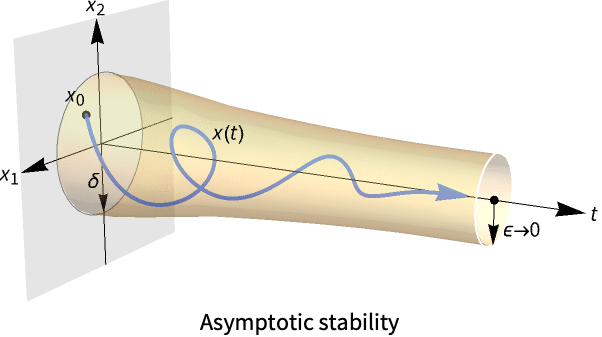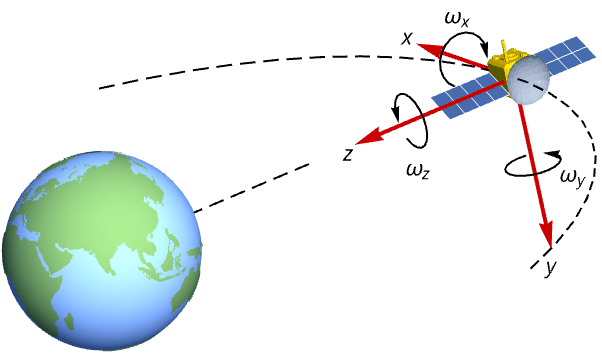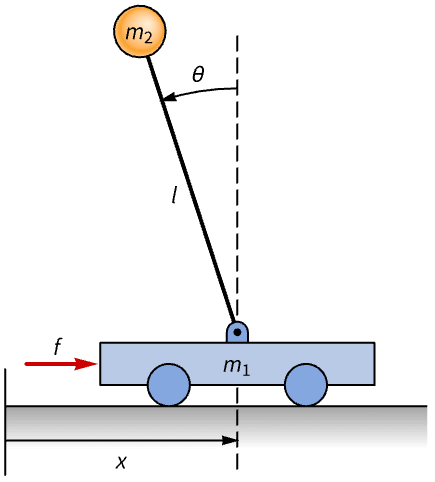DStabilityConditions[eqn,x[t],t]
gives the fixed points and stability conditions for a differential equation.
DStabilityConditions[{eqn1,eqn2,…},{x1[t],x2[t],…},t]
gives the fixed points and stability conditions for a system of differential equations.
DStabilityConditions[{eqn1,eqn2,…},{x1[t],x2[t],…},t,{pnt1,pnt2,…}]
gives the stability conditions for the given fixed points.


DStabilityConditions
DStabilityConditions[eqn,x[t],t]
gives the fixed points and stability conditions for a differential equation.
DStabilityConditions[{eqn1,eqn2,…},{x1[t],x2[t],…},t]
gives the fixed points and stability conditions for a system of differential equations.
DStabilityConditions[{eqn1,eqn2,…},{x1[t],x2[t],…},t,{pnt1,pnt2,…}]
gives the stability conditions for the given fixed points.
Details and Options

- Stability is also known as asymptotic stability, and fixed points are also known as equilibrium points or stationary points.
- DStabilityConditions is typically used to qualitatively analyze long-term behavior near fixed points. If the system is stable, then solutions converge to the fixed point if you are close enough.
- For a system of differential equations
 , a point
, a point  is a fixed point iff
is a fixed point iff  . In effect, the initial value
. In effect, the initial value  remains stationary; if you initialize at
remains stationary; if you initialize at  you stay at
you stay at  .
. - A fixed point
 is asymptotically stable iff for
is asymptotically stable iff for  and
and  you have
you have ![TemplateBox[{{x, (, t, )}, t, infty}, Limit2Arg]=x^* TemplateBox[{{x, (, t, )}, t, infty}, Limit2Arg]=x^*](Files/DStabilityConditions.en/10.png) for
for  sufficiently small.
sufficiently small. - DStabilityConditions returns a list of the form {{{
 ,
, ,…},cond},…}, where {
,…},cond},…}, where { ,
, ,…} is a fixed point.
,…} is a fixed point. - DStabilityConditions gives sufficient conditions for local stability of fixed points. For linear systems, these conditions are also conditions for global stability.
- DStabilityConditions works for linear and nonlinear ordinary differential equations.
- The following options can be given:
-
Assumptions $Assumptions assumptions on parameters

Examples
open all close allBasic Examples (5)
Find the fixed point and determine its stability for the equation ![]() :
:
Find the fixed point and determine the stability for the equation ![]() :
:
Find the fixed points and conditions for stability for the equation ![]() :
:
Plot several solutions for different values of a:
Stability analysis of a two-dimensional system:
Plot the parameter region for which the system is stable:
Find the fixed points for a nonlinear equation:
Scope (23)
Linear Equations (5)
Find the fixed point and determine its stability for the equation ![]() :
:
A first-order linear inhomogeneous equation:
Plot the unstable solution for ![]() :
:
Plot the stable solution for ![]() :
:
Plot the stability region for parameters ![]() and
and ![]() :
:
Higher-order inhomogeneous ODE:
Solve the ODE using coordinates of the fixed point as initial values:
Nonlinear Equations (3)
Stability analysis of a nonlinear differential equation:
Use StreamPlot to demonstrate the stability:
The stability of a first-order nonlinear equation:
Plot the solution for the initial value ![]() :
:
Use StreamPlot to demonstrate the stability at ![]() :
:
Consider a second-order nonlinear ODE:
DSolve is unable to solve this equation:
Analyze the stability of the equation using DStabilityConditions:
Linear Systems (11)
A stable linear system of uncoupled equations:
An unstable linear system of uncoupled equations:
The stability of a linear system with constant coefficients:
Use StreamPlot to visualize the stability:
Unstable system with constant coefficients:
Stable system with constant coefficients:
A first-order system with imaginary eigenvalues:
Use StreamPlot to visualize the stability:
Inhomogeneous unstable system:
Linear system with symbolic coefficients:
Use Assumptions to simplify the stability conditions:
Analyze the stability of a 10×10 linear system with random constant coefficients:
Nonlinear Systems (4)
A nonlinear first-order system:
Use StreamPlot to visualize the stability:
A nonlinear system with periodic fixed points:
A nonlinear system with unstable fixed point at origin:
Options (2)
Assumptions (2)
Without Assumptions, there are conditions on parameters for stability:
Using Assumptions can often result in simplified conditions:
A system of two nonlinear equations has an infinite number of periodic fixed points:
Use Assumptions to specify the range of a dependent variable:
Applications (11)
Physics (5)
Do stability analysis for the spring-mass system with damping:
Use assumptions to simplify the stability conditions:
Solve the spring-mass system equation:
Plot the solution for given values of parameters:
Do stability analysis for the electric circuit equation:
Solve the electric circuit equation:
Plot the solution for given values of parameters:
Stability analysis for the damped pendulum equation:
Plot the phase portrait of the system:
Plot the solution for the initial conditions ![]() ,
, ![]() :
:
Stable system of Lorenz equations:
Use StreamPlot3D to visualize the Lorenz attractors:
Biology and Ecology (3)
Stability analysis for the predator-prey model (Lotka–Volterra equation):
Plot the phase portrait of the system:
Solve the system for the initial conditions ![]() ,
, ![]() :
:
The Rosenzweig–MacArthur predator-prey model:
The chemostat model represents biological systems in which microorganisms grow on abiotic resources:
Chemistry (1)
Control Systems (2)
Analyze a satellite's attitude dynamics starting from Euler's equations of motion:

Euler’s equations with principal moments of inertia ![]() ,
, ![]() ,
, ![]() :
:
Analyze the stability of the equation for fixed values of ![]() ,
, ![]() ,
, ![]() :
:
Choose the fixed point as an operating point:
Construct a state-space model:
The satellite’s attitude is unregulated if disturbed:
Verify the controllability of the model:
Study an inverted pendulum using the Lagrangian:

The kinetic energy of the cart and pendulum:
Properties & Relations (9)
DStabilityConditions returns fixed points and stability conditions for differential equations:
Use DFixedPoints to find all fixed points of a differential equation:
Analyze the stability at specific fixed points:
Use DFixedPoints to find all fixed points of a nonlinear ODE:
Use Solve to find the fixed points:
Linearize the equation near the first fixed point:
Check the stability near the first fixed point:
Linearize the equation near the second fixed point:
Check the stability near the second fixed point:
Determine the stability of a nonlinear equation using DStabilityConditions:
The fixed points for the n![]() -order differential equation are n-dimensional vectors:
-order differential equation are n-dimensional vectors:
The fixed points for the system of n first-order differential equations are n-dimensional vectors:
Analyze the stability of a system of two ODEs:
Use DSolveValue to solve the system using a fixed point as initial condition:
Use DSolveValue to solve the system for given initial conditions:
Analyze the stability of a nonlinear ODE:
Solve the ODE using NDSolve:
Analyze the stability of a nonlinear ODE:
Calculate an asymptotic solution of the ODE using the first fixed point as initial condition:
Calculate an asymptotic solution of the ODE for another initial condition:
Find the fixed points for the system of two nonlinear ODEs:
Calculate the Jacobian matrix of the system:
Calculate the eigenvalues of the Jacobian matrix for each fixed point:
The system is locally stable near the fixed point if all of the eigenvalues have negative real parts:
Check the stability of the points using DStabilityConditions:
Possible Issues (2)
Sometimes the conditions for stability are not the simplest possible:
Additional simplification can be achieved by further processing:
DStabilityConditions fails because the given point is not a fixed point:
Use DFixedPoints to find all fixed points of the equation first:
Neat Examples (2)
The van der Pol oscillator is a non-conservative, oscillating system with nonlinear damping:
Analyze the stability of the system:
Animate the trajectories of the system for various values of the parameter ![]() :
:
The FitzHugh–Nagumo model is an example of a relaxation oscillator:
If the external stimulus s exceeds a certain threshold value, the system will exhibit a characteristic excursion in phase space, before the variables x and y relax back to their rest values.
Visualize the trajectories of the system for various values of the parameter s:
Related Guides
History
Text
Wolfram Research (2024), DStabilityConditions, Wolfram Language function, https://reference.wolfram.com/language/ref/DStabilityConditions.html.
CMS
Wolfram Language. 2024. "DStabilityConditions." Wolfram Language & System Documentation Center. Wolfram Research. https://reference.wolfram.com/language/ref/DStabilityConditions.html.
APA
Wolfram Language. (2024). DStabilityConditions. Wolfram Language & System Documentation Center. Retrieved from https://reference.wolfram.com/language/ref/DStabilityConditions.html
BibTeX
@misc{reference.wolfram_2025_dstabilityconditions, author="Wolfram Research", title="{DStabilityConditions}", year="2024", howpublished="\url{https://reference.wolfram.com/language/ref/DStabilityConditions.html}", note=[Accessed: 30-December-2025]}
BibLaTeX
@online{reference.wolfram_2025_dstabilityconditions, organization={Wolfram Research}, title={DStabilityConditions}, year={2024}, url={https://reference.wolfram.com/language/ref/DStabilityConditions.html}, note=[Accessed: 30-December-2025]}